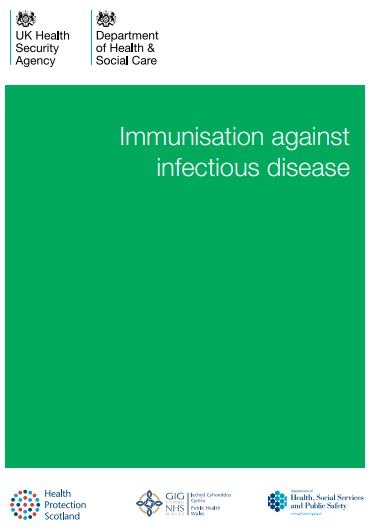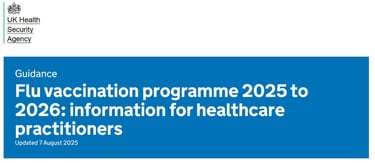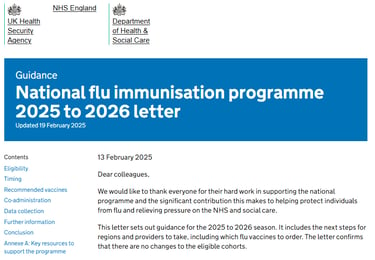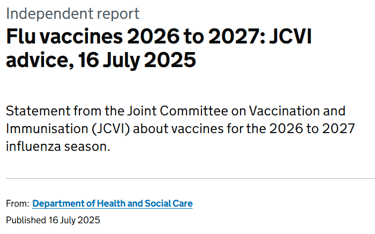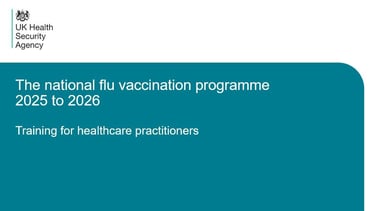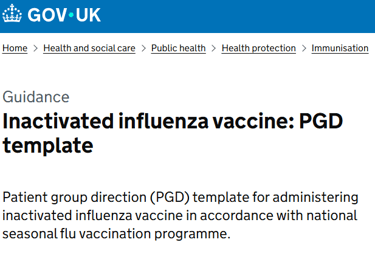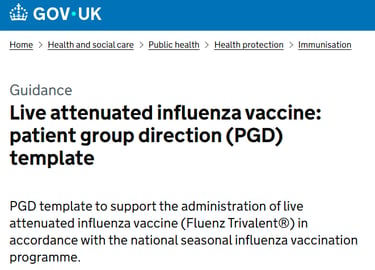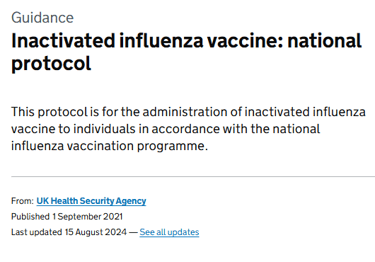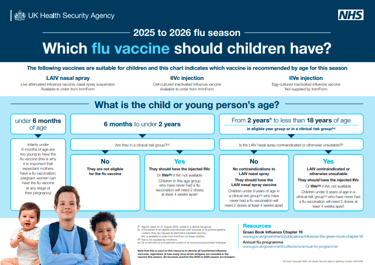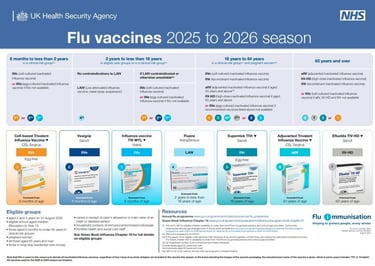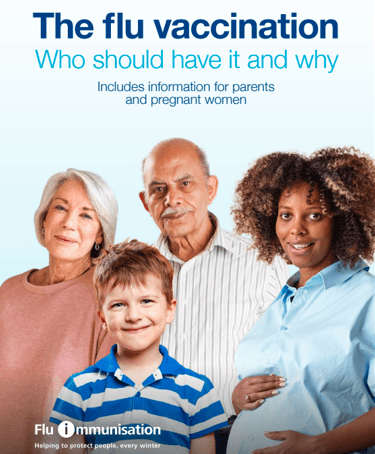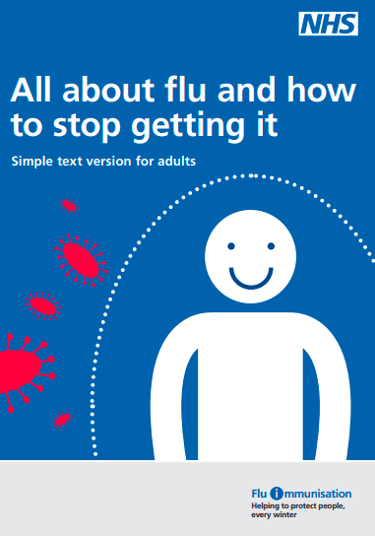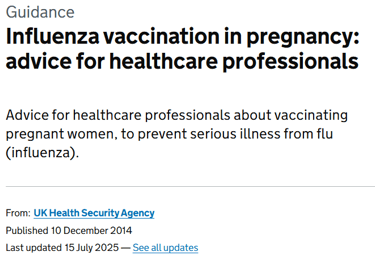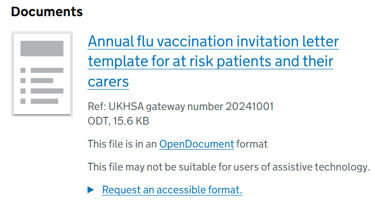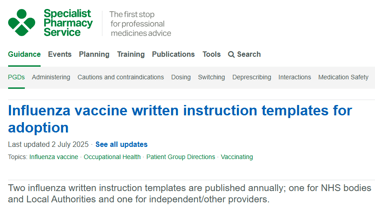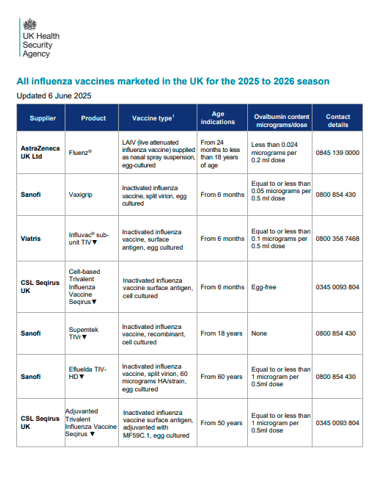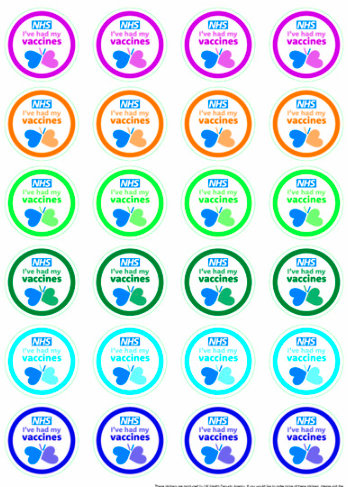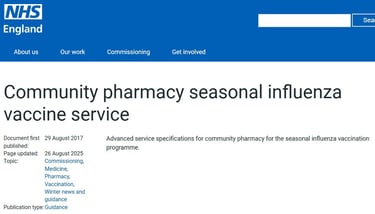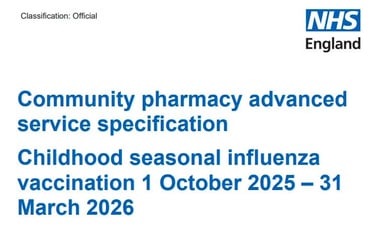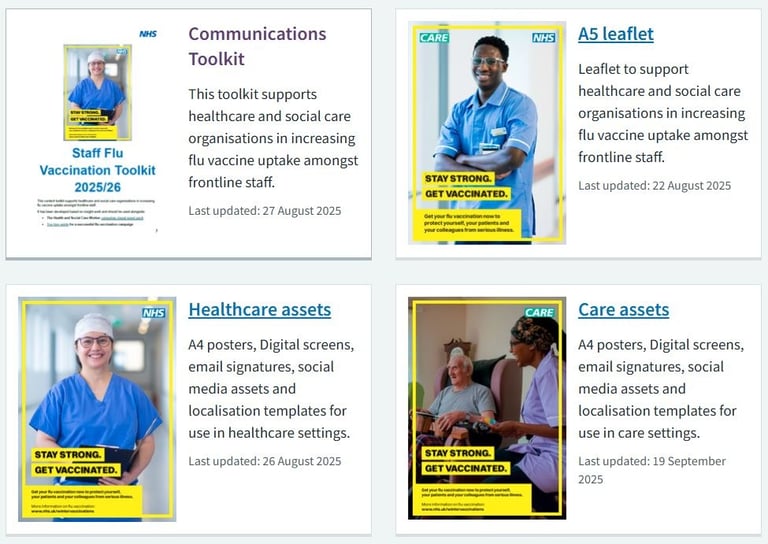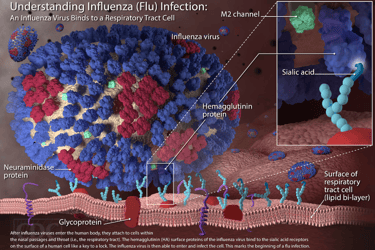Stay Awesome

Keeping up to date: Things to know in practice for 25/26:
EVERYTHING YOU NEED TO KNOW ABOUT DELIVERING THE CURRENT INFLUENZA SEASON: Definitely have a browse on that link – you will find everything you need regarding the latest information on flu including slide sets, posters, training modules, and administration videos.
NHS England has launched the staff flu vaccination campaign resources for 2025/26. They include a range of visuals, messaging, scripts, Q&As, a leaflet and top tips. A call to action letter was cascaded to system leaders to support improving staff flu vaccine uptake as a national priority. Together with UKHSA, a winter vaccination communications toolkit for stakeholders has also been published.
27th November: Well this is interesting: Of all frontline healthcare workers 29.8% have been vaccinated for influenza (285,622 of 958,296) up to now. This includes NHS trusts (secondary care) and GP practices (primary care). NHS trusts (secondary care) represent data from acute, ambulance, care, community, mental health, other NHS trusts and independent sector health care providers (ISHCPs). Broken down by primary and secondary care, the totals are 29.7% (282,046 of 949,918) for NHS trusts, and 42.7% (3,576 of 8,378) for GP practices. The over 65's are at 60.9%, at risk groups 28.5%, pregnant women 29.5%, 2 and 3 year olds are at 33% each. On the schools programmes, reception and year one are doing the best at 33% (as well) and it goes downhill from there with the lowest uptake (18.1%) being 15-16 year olds.
11th Nov: Fortunately, the 2025/26 vaccine is currently 70 to 75% effective at preventing hospital attendance in children aged 2 to 17 years and 30 to 40% effective in adults. This is encouraging since the rogue mutation in the summer where a drifted influenza A(H3N2) strain (also now known as subclade K) currently dominates cases in England. The protection levels observed in children are particularly encouraging this year.
6th Nov: Over 5 million under 65s with a long-term health condition could miss out flu vaccine. The UKHSA (and me) is concerned that many people at risk may not know they are eligible for a flu vaccine.
23rd October: Update to the Guidance for healthcare practitioners on the national influenza immunisation programme. New Common Issue added: Inadvertent administration of the recombinant inactivated influenza vaccine (IIVr) to a child under 18 years.
23rd October: To date we have vaccinated over 10.4 million (10,436,395) against flu and almost three million (2,987,313) against COVID. Well done all!!
16th October: US documents dozens of new avian flu cases in wild birds as PAHO notes human case
9th October: Amazing job everyone!!! You have vaccinated nearly a million more people against flu so far this autumn compared to last year.
3rd September: Useful new guidance has just appeared with loads of good tips for planning for flu uptake increases. Do have a browse! Flu vaccine for children: best practice guide for GPs: Guidance and Leaflet for GPs and practice staff to support the nasal spray flu vaccination programme for children. I've put it in the hesitancy and uptake section as well so it doesn't get lost in the news feed. This Astrazeneca site has some useful resources around Fluenz too.
1st September: To kick off September a Vaccine Update flu special arrived. Good luck to the school nurses and staff providing maternity services on the commencement of the flu programme for those groups.
21st August: The flu poster for this year has finally landed!
Something new for the 2025 to 2026 flu season is that it will be possible for community pharmacies to offer vaccination to children aged 2 and 3 years.
8th August: New addition of an addendum to the LAIV PGD. Why? Well, since the publication of the PGD, the SPC went through an update on 21 July 2025 to the ‘Qualitative and quantitative composition’ section with the formula of the active strains. The updated SPC was published on the EMC on 23 July 2025. The addendum has been provided to the PGD to inform of the updated active strains. Nothing major to worry about there.
7th August: The flu training slide set is here.
25th June: Previous Flu immunisation training recommendations withdrawn due to new National Minimum Standards being published.
28th July: Inactivated influenza vaccine: The national protocol is here! And more flu updates as there has been an amendment to the national flu immunisation programme 2025 to 2026 letter to include pharmacy provision. Also - here's the updated inactivated vaccine PGD. Getting really flu-ready now!
18th July: Some programme resources updated: Added pages: ‘Flu vaccination: letter template for at risk patients and carers’, ‘When you should get your flu vaccination’, ‘Flu vaccines for children and young people for 2025 to 2026’, ‘Flu vaccination: simple text information for adults and children’.
1st July: Live attenuated influenza vaccine: patient group direction (PGD) template updated
29th May: One or two additions to the annual flu programme resources - take a look. Also - an update to the Green Book chapter: Updated information on co-administration, seasonal timing of vaccination, vaccine terminology (to future proof wording on quadrivalent and trivalent vaccines), disease surveillance, vaccine uptake, risk groups and occupational health section. Also, the UK Influenza annual epidemiological reports are in.
22nd May: UKHSA data released today shows the flu vaccine prevented 96,000 to 120,200 hospitalisations in England during last winter. Lot of uptake data trickling through too today- see the school vaccine uptake here, the frontline HCP data here, and the GP patients data here. On the whole, it seems pretty disappointing with most risk groups and eligible people down on last years uptake stats. Pregnant women seem to have done slightly better for uptake though on last year.
21st May: Updated: Flu vaccination guidance and resources for schools.
20th May: Updated today- flu vaccination: letter template for children aged 2 and 3 years. GP practices can use this template to invite parents and guardians to get their child vaccinated at the local surgery.
27th March: 38.1% of frontline healthcare workers have been vaccinated for influenza- GP surgeries seem to be doing the best for healthcare worker uptake according to the charts. In the other eligible flu cohorts, up to Feb 2025, The over 65's are on top at 74.9% uptake. The clinical risk groups from 6m to 65y are at 40%, pregnant women are at 35%, and 2 and 3 year olds are hovering around 40% uptake.
"The World Health Organization (WHO) has concluded that B/Yamagata lineages are no longer circulating and are unlikely to cause future epidemics, and that inclusion of a B/Yamagata antigen as a component of influenza vaccines is no longer warranted. WHO has stated that every effort should be made to exclude this as soon as possible, across all vaccine types. To this end, manufacturers have been preparing to move to trivalent formulations"
Useful supplementary training documents:
Videos: administering nasal flu also this one
Leaflets and posters to support flu vaccination for children (with translated resources too!)
Strains in the vaccines this year:
Egg-based vaccines:
A/Victoria/4897/2022 (H1N1)pdm09-like virus
A/Croatia/10136RV/2023 (H3N2)-like virus
B/Austria/1359417/2021 (B/Victoria lineage)-like virus
Cell culture- or recombinant-based vaccines:
A/Wisconsin/67/2022 (H1N1)pdm09-like virus
A/District of Columbia/27/2023 (H3N2)-like virus
B/Austria/1359417/2021 (B/Victoria lineage)-like virus
Things to know in practice for 26/27:
15th Dec 2025: Service specification is out for community pharmacy seasonal vaccination services – COVID-19 and influenza vaccination advanced services. For the first time the COVID-19 and adult influenza vaccination service specifications have been combined into one document, although contractors can still sign up to deliver adult influenza vaccinations only. Communications about the two-three-year-old flu vaccination service will be separate, pending the outcomes of the evaluation of this year’s pilot.
16th July: Statement from the Joint Committee on Vaccination and Immunisation (JCVI) about vaccines for the 2026 to 2027 influenza seasonProgramme (updated Nov 2025 following JCVI advice in October 2025 that IIV-HD can be considered for use from the age of 50 years.)
Things to know in practice about previous years:
Vaccine uptake in 24/25 was similar to 2023/24, reaching almost 75% in adults over 65 years, 35% in pregnant women, and 40% in clinical risk groups.
Uptake in adults over 65 years increased during the COVID-19 pandemic but is now returning to pre-pandemic levels. However, as the size of the older adult population is increasing year on year, more people are being vaccinated to achieve the same uptake percentage (e.g. 5.9 million in 2009/10 vs 7.6 million in 2019/20). The same pattern is not seen for clinical risk groups, with uptake remaining relatively stable during the COVID-19 pandemic and dropping now to the lowest levels recorded since before 2009/10.
The programme for pregnant women was introduced in 2010/11 with the highest uptake in 2017/18 (47%). Uptake has been falling since. The JCVI commented in their June minutes this:
"It was noted that there had been a shift towards maternity services providing vaccination since the COVID-19 pandemic, instead of GPs, which was challenging as it was not something midwives had previously done, whereas GP surgeries have typically had a designated immunisation nurse to advocate for vaccination. This may be a factor in the recent decline of vaccine coverage in pregnant women."
In the children’s programme, 24/25 vaccine uptake in children aged 2 and 3 years old was almost 44% and 42%, respectively, almost 55% in primary school children and almost 45% in secondary school children. Uptake in 2- and 3-year-olds increased during the COVID-19 pandemic but has since returned to previous levels.
Vaccine uptake in frontline healthcare workers dropped in 24/25 to almost 38%, (lowest in midwives) and this is the lowest recorded level since 2010/11. The highest uptake (almost 77%) was recorded during the first year of the COVID-19 pandemic in 2020/21. That's us guys. Get your own flu vaccine appointments booked in this year and let's get those disappointing stats up!
During last years 2024/25 influenza season in the UK, the predominant circulating strains were:
Influenza A(H1N1)pdm09: This strain, originally responsible for the 2009 Swine Flu pandemic, has continued to circulate and was a significant contributor to the season’s cases.
Influenza A(H3N2): Co-circulated with A(H1N1)pdm09, contributing to the seasonal influenza burden.
Influenza B/Victoria lineage: Detected towards the end of the season.
Notably, no wild-type B/Yamagata strain viruses have been detected since March 2020, suggesting possible eradication.
So, Influenza A(H1N1) dominated for most of the 24/25 season, with influenza B activity increasing in January in younger age groups. There was limited influenza A(H3N2) activity. In subtype-specific analyses across the age groups, moderate VE was demonstrated against influenza A(H1N1) and A(H3N2). Protection against
influenza B was good across all age groups. Waning effectiveness for influenza A, but not influenza B, was seen in adults.
UKHSA highlighted recently published modelling estimates which suggested that vaccination had prevented approximately 100,000 hospitalisations in the 2024/25 season in England. Strong work flu vaccine!!!

Reminders:
No need to expel the air bubble in pre-filled syringes
Don't forget travellers!
Store at 2–8°C; IM injection or nasal spray
Keep an eye on dual clinics with COVID boosters—often offered together.
Look out for any info on combined flu and COVID-19 vaccines appearing.
Don't forget to use that appointment to check for any other outstanding or eligible vaccines!
Children under 9yrs in clinical risk groups who have never received a vaccine for flu before should be offered two doses 1 month apart.
Have YOU checked your own vaccine status as a HCP?
Other useful links and resources

Want to geek out? Go deeper here:
Dec 2025: Bird flu has a heat-proof gene that protects it from our fever defenses
Oct 2025: The Coalition for Epidemic Preparedness Innovations (CEPI) is partnering with the Serum Institute of India, the largest vaccine manufacturer in the world, to develop a new vaccine targeting H5N1 avian flu that elicits a broad immune response across multiple H5 viral strains. The vaccine candidate is intended to serve as a prototype vaccine for Disease X, a yet-to-arise pathogen with pandemic potential. This project is part of CEPI’s 100 Days Mission aimed at having a vaccine within 100 days of identifying a new pandemic threat.
June 2025: Travel healthers take note! Knowledge, attitudes, practices and vaccine acceptance towards seasonal influenza vaccination among international travelers: a cross-sectional survey in Thailand. Conclusions here if you haven't got time to read: International travellers know about flu but don't know about prevention options like vaccinations. Low vaccine acceptance rates were observed among international travellers. Travel consultations should focus on influenza awareness while traveling and associated preventative measures.
7th May 2025: I was wondering what the latest was on the combined flu and COVID vaccine, and then Fray very kindly sent me this: Moderna's combo Covid and flu mRNA shot outperforms current vaccines in large trial
8th May 2025: In the guardian today was this sad CDC info: Child deaths from flu in the US are at their highest level in 15 years with at least 216 children dying during this past season
22nd April 2025: Universal nasal flu vaccine? This was an intriguing news snippet from CIDRAP: New agreement geared toward universal avian flu vaccine.
3rd April 2025: Will We See a Bird Flu Vaccine Next Year? And another relevant article: Everything You Need to Know About Bird Flu
24th March 2025: Sheep flu!!! First case of bird flu in sheep found on UK farm
25th Feb 2025: BMJ news: Robert F Kennedy cancels flu vaccination ad campaign and key vaccine policy meeting. And at the same time, this headline: Bird flu: Two patients in US admitted to hospital with H5N1 as concerns over spread grow
(The UK has purchased 5 million bird flu vaccines, just FYI)
12th Nov 2024: Teenager in critical condition with Canada’s first human case of bird flu
16th October 2024: Brilliant article: Is it time to freak out about bird flu?
JUNE 2024 Adolescent vaccination programme in secondary schools for 2024 to 2025. Information on the adolescent vaccination programme delivered in secondary schools and the role that schools play.
Interesting Telegraph article April 2024 - avian flu - one to watch. Bird flu (or H5N1) could evolve to become a pandemic flu strain one of two ways. One, by gradually acquiring mutations that give it the ability to easily infect and spread among people, or two, by swapping genetic material with other flu viruses, such as H3N2 or H1N1, the influenza A viruses that circulate and cause illness during the flu season. That gene swapping (a process called reassortment) can occur when an animal or a person is infected at the same time with two or more flu A viruses.
Handy short video from WHO on Zoonotic flu, and a free webinar recording on flu uptake delivered by my lovely mate and fellow vaccination enthusiast, Laura
Find uptake data here: Seasonal influenza vaccine uptake in children of school age: monthly data, 2024 to 2025 and Seasonal influenza and COVID-19 vaccine uptake in frontline healthcare workers: monthly data 2024 to 2025
Improving influenza vaccine uptake in clinical risk groups: patient, provider and commissioner perspectives on the acceptability and feasibility of expanding delivery pathways in England
Trials offer conflicting findings on high-dose vs standard-dose flu vaccines in older adults
Sept 2025: Outbreak of highly pathogenic avian influenza a(H5N1) among house cats: A case series involving oseltamivir treatment AND FDA Notifies Pet Owners That Tests Show H5N1 Contamination in Certain Lots of RAWR Raw Cat Food Chicken Eats

What is Influenza anyway?
Influenza—aka “flu”—is a contagious virus that comes around every year, just like bad Christmas telly. It mutates fast, spreads faster, and comes in seasonal waves. It’s not just a heavy cold—it can floor the fittest of us and cause serious complications, especially in vulnerable groups.
What happens If you catch it?
Think fever, chills, muscle aches, sore throat, cough, and “hit by a bus” fatigue. For most, it’s a week or two of misery. But for some—especially the very young, the elderly, or those with underlying health conditions—it can lead to pneumonia, hospitalisation, or worse.
How does It Spread?
It’s airborne—spread through coughs, sneezes, and shared air in crowded places (yes, public transport counts). You can also pick it up from surfaces if you touch your face before washing your hands. The virus can live for around 24 hours on surfaces. Most UK cases of flu occur between December and February.
Does getting flu make you Immune?
Not for long. Flu mutates regularly, so immunity to one strain doesn’t mean you’re protected against the next. That’s why the vaccine changes yearly and why an annual jab is essential for those at risk.
Can it be treated?
Antivirals like oseltamivir can help—but only if taken early (within 48 hours). Mostly, it’s about managing symptoms, staying hydrated, and letting it run its course. For high-risk individuals, early treatment is more important.
Who’s most at risk?
Infants under 6 months (especially before they can be vaccinated - hence the maternal vaccination program), pregnant people, adults over 65, healthcare workers and carers of young babies, and adolescents, people with long-term conditions (e.g. asthma, diabetes) and immunocompromised individuals.

Top reasons to encourage vaccination (when indicated):
Prevents infant hospitalisation and death
Part of UK adult, maternal, and childhood schedule
Required in many healthcare roles. Protect yourself, your colleagues, and your patients. Plus, prevent time off work (or worse, working while unwell)
Influenza leads to hundreds of thousands of GP visits and more than ten thousand hospital stays each year.
Flu epidemics can kill thousands or even millions of people. The 1918 flu epidemic is estimated to have affected half the world's population. 40-50 million people died worldwide. It could literally save a life
In the UK it is estimated that an average of 600 people a year die from complications of flu. In some years it is estimated that this can rise to over 10,000 deaths. The WHO estimates that between 250,000 and 500,000 people around the world die from the flu every year.
Protect the community. Around 1 in 3 people infected by the flu virus will not show any symptoms.

